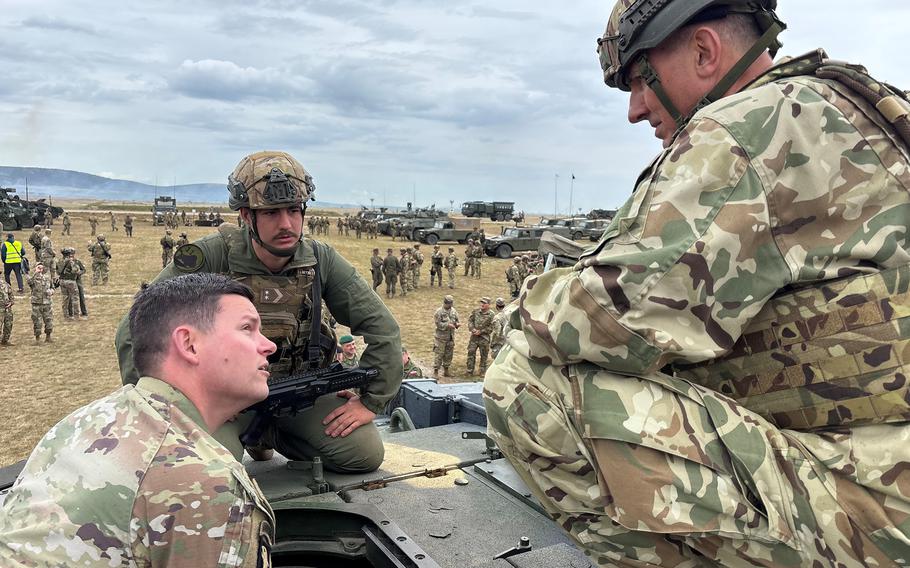
Maj. Andrew Hayden, aide-de-camp to V Corps commander Lt. Gen. Charles Costanza, gets a tour of the Hungarian Leopard 2A7 main battle tank after a joint fire support operation during exercise Saber Guardian in Veszprem, Hungary, on June 16, 2025. (Matthew M. Burke/Stars and Stripes)
VESZPREM, Hungary — Hungarian army Cpl. Peter Walsch waited for the ordnance to stop falling to poke his head into an American Stryker vehicle for a chat with a group of U.S. Army medical personnel.
A drone pilot assigned to Hungary’s noncommissioned officer academy in Szentendre, Walsch wanted to know about U.S. Army battlefield triage techniques.
The conversation with combat medic Sgt. David Cook of the 2nd Cavalry Regiment seamlessly switched to food, travel, family and why each man chose to serve. Both said they wanted to be a part of something bigger and care for their young families.
“We have a lot in common,” Walsch said. “(The U.S. soldiers) are professionals so they know what they’re doing. It’s always a good exchange of experiences, how they do their drills and how they react.”
He and Cook exchanged contact information and vowed to meet someday for Hungarian goulash.
“Just exchanging that information brings the nations together,” Cook said. “Understanding commonality between each other is always a good foundation to have.”
Walsch and Cook were among the approximately 2,650 soldiers from Hungary, the U.S. and Spain at the Zero Point Firing and Training Range in Veszprem on Monday as part of the biennial Saber Guardian exercise.
Approximately 400 U.S. soldiers from the 2nd Cavalry Regiment and the Ansbach-based 52nd Air Defense Artillery Brigade traveled overnight in 116 vehicles through the Czech Republic and Slovakia to be there. They were ready to fight within eight hours of arrival.
The training in Veszprem included urban warfare and the coordinated assault Monday by helicopter gunships, tanks, fighting vehicles, artillery and mortars.
Monday’s drills started with the identification of simulated enemy forces using a combination of aircraft and reconnaissance. The targets, including enemy air defenses, were softened with an array of mortar and artillery strikes.
Then, over a dozen Hungarian Lynx infantry fighting vehicles, Leopard 2A7 battle tanks, U.S. Strykers, Spanish Centauro combat and reconnaissance vehicles, and lighter ground surveillance vehicles moved forward methodically, providing covering fire for one another as they destroyed vehicle targets downrange.
In one final flurry, the Strykers launched several TOW anti-tank missiles. The action left fires burning in the hulks of smoldering vehicles long afterward.
Lt. Col. James Anderson, commander of 4th Squadron, 2nd Cavalry Regiment and commander of ground forces for the exercise, was pleased. The exercise sends a distinct message, he said.
“The biggest takeaway from this is the U.S. Army’s ability to travel over incredibly long distances very rapidly and deliver a lot of lethality really fast,” he said. “If you’re an adversary, you don’t want us to show up.”
The range at Veszprem is in western Hungary about 275 miles from the country’s border with Ukraine, where war continues to rage more than three years after Russia’s full-scale invasion.
The threat posed by Russia cast an ever-present shadow that loomed over the exercise, Lt. Gen. Charles Costanza, commander of the Army’s V Corps, said after the maneuvers concluded.
“I think the biggest thing is that for (the Hungarians), the threat from Russia is real,” Costanza said. “We have to learn how to fight together.”
NATO Secretary-General Mark Rutte said last month that Russia could reconstitute its armed forces and be prepared to attack the alliance within five years.
Saber Guardian runs through June 24 and includes training in Germany, Hungary and Romania, an Army statement said. Approximately 10,000 troops will participate in convoys, river crossings, aerial operations and live-fire events.
Relations between the U.S. and Hungary, both NATO allies, have markedly improved recently, Hungarian defense chief Gen. Gabor Borondi said in an interview Monday.
U.S. President Donald Trump is known to have a positive relationship with Hungarian Prime Minister Viktor Orban. Trump called Orban a “great man” during a conservative conference in May.
Tensions dating to a 2015 migrant crisis and other factors had strained the relationship, Borondi recalled.
Hungary has a strong commitment to NATO and bilateral ties with the U.S., Borondi said, adding that the Hungarians communicate in English during training and use the same tactics, techniques and procedures as the Americans do.
“We are one team,” he said.